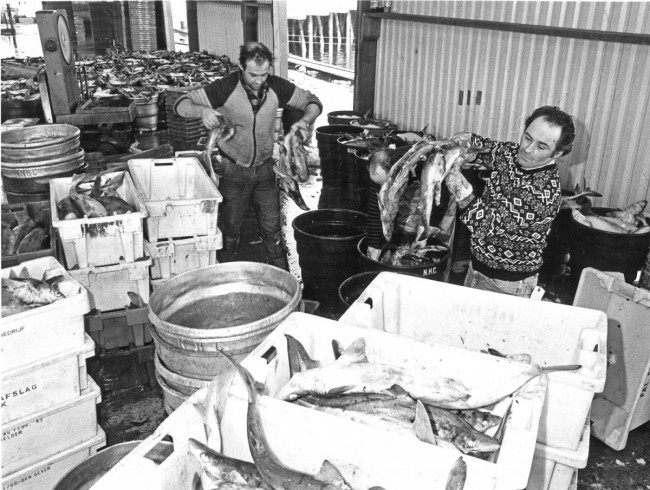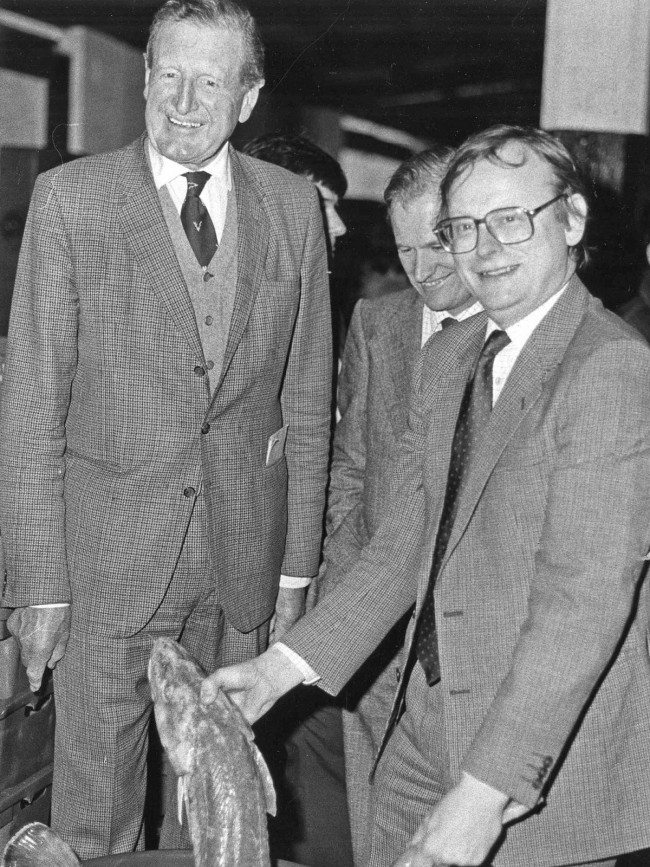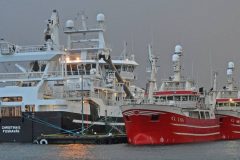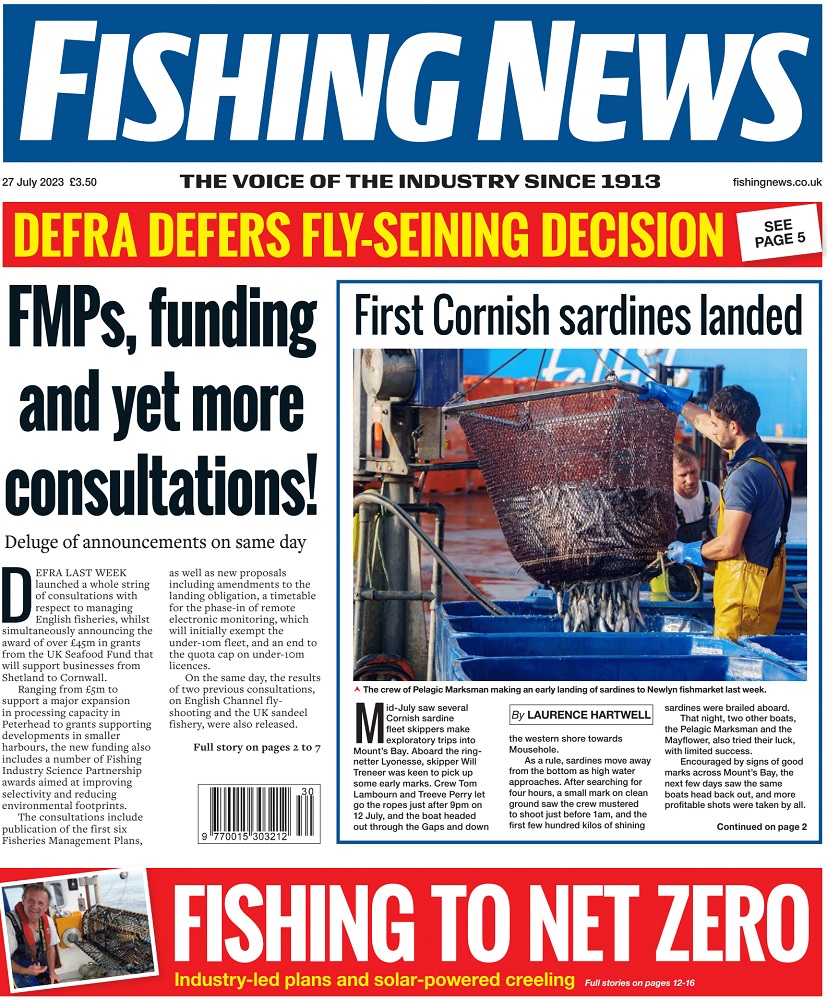Situated at the south-west tip of Britain in close proximity to inshore and offshore grounds near Lands’ End, yielding a wide variety of catches, Newlyn harbour has a longstanding and proud tradition of being a prominent fishing port.
Newlyn today is home to one of the most diverse locally-owned fleets in the UK, including beamers, netters, potters and trawlers. This mix of vessels reflects the constant changes that Newlyn, like most other ports, has experienced down the years.
The main photograph (above) shows a large catch of hake, taken by the Newlyn-based fly seiner Dew Genen Ny PZ 185, skippered by Robert George, filling the floor of the old market building at Newlyn in 1984.
Newlyn market has also often seen large catches of single species at the end of a neap tide period when the netting fleet all land together.
In this instance the fish is hake but spurdog, pollack, ling and ray have sometimes landed in large quantities by long-liners and netters.
The local fleet grew exponentially during the mackerel boom of the ‘seventies but the fisheries’ sudden collapse in the early ‘eighties meant that boats had to diversify into other methods and species.
In Photograph 2, staff from Falmouth Fishselling Co Ltd sort and box spurdogs on Newlyn fish market.
The seasonal spurdog fishery, which was traditionally carried out by long-liners from Newlyn and Padstow, often resulted in a glut of fish landed onto Newlyn market, leading to a shortage of space and fish boxes. Market staff sometimes had little choice but to leave sorted catches unboxed and in piles, ready for auction in the open air all along Mary Williams pier.
The fish in the photo were caught by the Padstow long-liner Pilot Star skippered by David Chapman.
In the third photograph, a fish auction is taking place in a temporary shed at Newlyn while the market was being rebuilt in 1987. The rapid expansion of the fleet in the preceding 10 years had left the market infrastructure struggling to cope with the throughput of fish, and the opening of the new fishmarket in 1988, was welcomed by all involved.
Newlyn has always been heavily reliant on the export market for its fish, with species such as hake finding much greater demand in Spain than it does in the UK.
While normally a well-honed process, the logistics of fish export can occasionally run into problems if there are industrial disputes or civil unrest on the continent – highlighted by the current problems of export lorries backed up on the M20 in Kent in Operation Stack.
Photograph 4 is of the then Conservative party chairman, John Selwyn Gummer (right) holding up a ling, accompanied by Major Simon Bolitho (left) and David Harris, Conservative MP for St. Ives (centre) on a visit to Newlyn fish market in September 1985.
Ling was a mainstay of the Newlyn long-line fleet throughout the ‘seventies and into the ‘eighties, when gill-netting took over the mantle as Newlyn’s dominant fishing method.
Gill netters continued to catch ling in large quantities, especially when wreck netting during the winter months.
Martin Johns
Read more from Fishing News here…
Situated at the south-west tip of Britain in close proximity to inshore and offshore grounds near Lands’ End, yielding a wide variety of catches, Newlyn harbour has a longstanding and proud tradition of being a prominent fishing port.
Newlyn today is home to one of the most diverse locally-owned fleets in the UK, including beamers, netters, potters and trawlers. This mix of vessels reflects the constant changes that Newlyn, like most other ports, has experienced down the years.
The main photograph (above) shows a large catch of hake, taken by the Newlyn-based fly seiner Dew Genen Ny PZ 185, skippered by Robert George, filling the floor of the old market building at Newlyn in 1984.
Newlyn market has also often seen large catches of single species at the end of a neap tide period when the netting fleet all land together.
In this instance the fish is hake but spurdog, pollack, ling and ray have sometimes landed in large quantities by long-liners and netters.
The local fleet grew exponentially during the mackerel boom of the ‘seventies but the fisheries’ sudden collapse in the early ‘eighties meant that boats had to diversify into other methods and species.
In Photograph 2, staff from Falmouth Fishselling Co Ltd sort and box spurdogs on Newlyn fish market.
The seasonal spurdog fishery, which was traditionally carried out by long-liners from Newlyn and Padstow, often resulted in a glut of fish landed onto Newlyn market, leading to a shortage of space and fish boxes. Market staff sometimes had little choice but to leave sorted catches unboxed and in piles, ready for auction in the open air all along Mary Williams pier.
The fish in the photo were caught by the Padstow long-liner Pilot Star skippered by David Chapman.
In the third photograph, a fish auction is taking place in a temporary shed at Newlyn while the market was being rebuilt in 1987. The rapid expansion of the fleet in the preceding 10 years had left the market infrastructure struggling to cope with the throughput of fish, and the opening of the new fishmarket in 1988, was welcomed by all involved.
Newlyn has always been heavily reliant on the export market for its fish, with species such as hake finding much greater demand in Spain than it does in the UK.
While normally a well-honed process, the logistics of fish export can occasionally run into problems if there are industrial disputes or civil unrest on the continent – highlighted by the current problems of export lorries backed up on the M20 in Kent in Operation Stack.
Photograph 4 is of the then Conservative party chairman, John Selwyn Gummer (right) holding up a ling, accompanied by Major Simon Bolitho (left) and David Harris, Conservative MP for St. Ives (centre) on a visit to Newlyn fish market in September 1985.
Ling was a mainstay of the Newlyn long-line fleet throughout the ‘seventies and into the ‘eighties, when gill-netting took over the mantle as Newlyn’s dominant fishing method.
Gill netters continued to catch ling in large quantities, especially when wreck netting during the winter months.
Martin Johns
Read more from Fishing News here…








